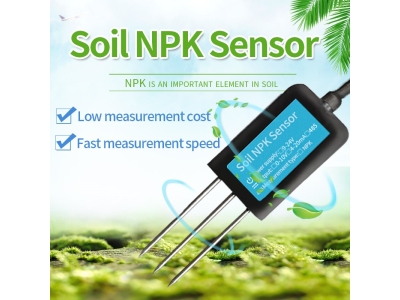Soil health plays a crucial role in sustainable agriculture and ecosystem stability. Over the past few decades, climate change has emerged as a significant global concern, impacting various aspects of o

ur environment, including soil conditions. Understanding the relationship between soil health and climate change is essential for developing effective strategies to mitigate the effects of climate change on agriculture and ensure long-term food security. In this article, we will explore how temperature and moisture sensing technology can help us gain insights into this relationship and promote sustainable soil management practices.
The Impact of Climate Change on Soil Health:
Climate change affects soil health in several ways. Rising temperatures lead to increased evaporation rates, resulting in drier soils. This reduces water availability for plants and disrupts nutrient absorption, leading to decreased crop yields. Additionally, extreme weather events such as droughts and heavy rainfall can cause soil erosion, nutrient leaching, and compaction, further degrading soil health. These changes in soil conditions significantly impact agricultural productivity and the overall health of ecosystems.
Temperature and Moisture Sensing Technology in Soil Monitoring:
Temperature and moisture sensing technology provides a valuable tool for monitoring soil conditions and studying the impact of climate change on soil health. Advanced sensors embedded in the soil can accurately measure soil temperature and moisture content at various depths and time intervals. This data can be collected and analyzed using sophisticated software algorithms to provide real-time insights into soil dynamics.
Exploring the Relationship between Soil Temperature and Climate Change:
Soil temperature sensing technology allows us to study the relationship between soil temperature and climate change. Rising air temperatures due to climate change directly impact soil temperature, affecting microbial activity, nutrient availability, and plant growth. By collecting data on soil temperature fluctuations, scientists can assess the extent of these impacts and develop strategies to mitigate their negative effects.
For example, studies have shown that increased soil temperatures can accelerate the decomposition of organic matter, leading to reduced carbon sequestration in the soil. This contributes to the release of greenhouse gases into the atmosphere, further exacerbating climate change. By monitoring soil temperature changes, researchers can identify management practices that help mitigate these effects, such as implementing conservation tillage or incorporating cover crops to regulate soil temperature.
Understanding the Relationship between Soil Moisture and Climate Change:
Soil moisture sensing technology allows for a better understanding of the relationship between soil moisture and climate change. Changes in precipitation patterns due to climate change impact soil moisture availability, affecting plant water uptake, nutrient transport, and microbial activity. By collecting data on soil moisture levels, scientists can analyze the impacts of climate change on soil water dynamics and develop strategies for efficient irrigation and water management.
For instance, decreased soil moisture caused by droughts can lead to reduced crop productivity and increased susceptibility to pests and diseases. By monitoring soil moisture levels, farmers can adjust irrigation schedules, implement water-saving techniques, and employ precision agriculture practices to optimize water use efficiency and enhance crop resilience to changing climate conditions.
Promoting Sustainable Soil Management Practices:
Temperature and moisture sensing technology not only helps us understand the relationship between soil health and climate change but also promotes sustainable soil management practices. By providing real-time data on soil conditions, farmers can make informed decisions regarding irrigation, fertilization, and pest control, thereby minimizing resource wastage and reducing environmental impacts.
Moreover, this technology enables the development of predictive models that integrate climate data, soil health parameters, and crop growth patterns. These models can support farmers in optimizing their agricultural practices, improving soil fertility, and mitigating the negative effects of climate change on crop productivity.
Conclusion:
Temperature and moisture sensing technology plays a vital role in exploring the relationship between soil health and climate change. By providing accurate and real-time data on soil temperature and moisture content, this technology helps us understand the impacts of climate change on soil conditions and develop effective strategies for sustainable soil management. Through the integration of advanced sensing technologies, data analysis, and precision agriculture practices, we can work towards mitigating climate change effects on soil health, ensuring long-term food security, and promoting sustainable agricultural systems.





